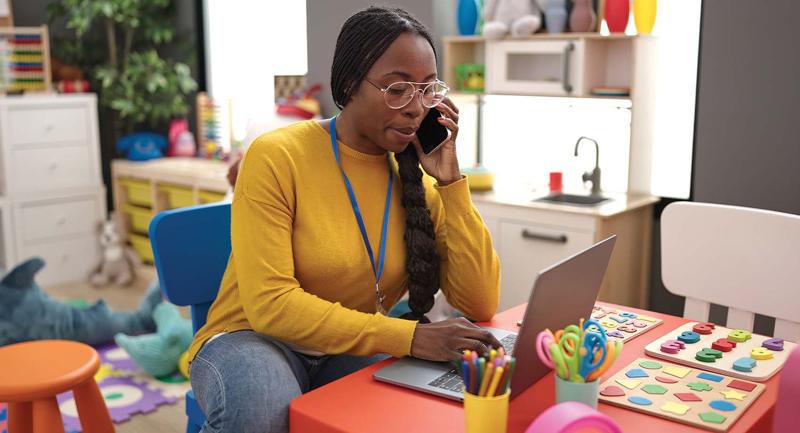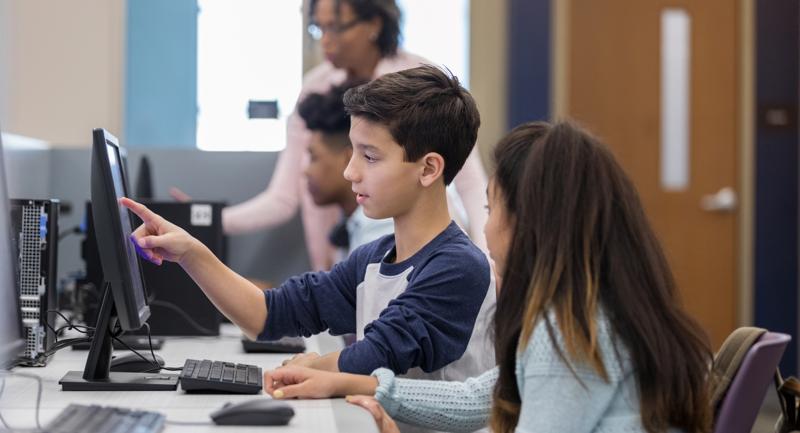Technology can transform teacher-centered classrooms into vibrant, student-centered learning environments, as Will Richardson described last year in this magazine (2019). Perhaps more frequently, though, enterprising classroom-tech initiatives flop. Often in these cases, a teacher's desire to activate student agency backfires; students end up needing frequent help from the teacher just to navigate the technology or complete the task.
Teachers know the familiar burn of frustration when students struggle to use a selected tech tool. They recognize the sinking feeling when, rather than taking off in their own direction on a new platform, students offer blank stares and requests to go to the bathroom. Instead of witnessing a rich creative process replete with new discoveries and expanded learning options, teachers often hear, after repeating directions and troubleshooting the software, "Why can't we just make a regular poster?"
Why do some technologies soar in classrooms, while others fail? This is not a trivial question; there is a lot of failure in ed-tech implementation. Every year, America's approximately 14,000 school districts are spending more than $8.4 billion on more than 7,000 ed-tech tools in the market (Technology for Education Consortium, 2017). And 59 percent of that spending is going toward tools that are never activated (27 percent) or used at less than 50 percent of their usage goals (32 percent) (LearnPlatform, 2019). Similarly, a 2019 GlimpseK12 study of 275 schools found that two-thirds of student software licenses go entirely unused.
Fortunately, we are starting to learn more about this chasm between potential and reality in ed-tech implementation. The Jefferson Education Exchange, the nonprofit ed-tech research organization we are part of, is attempting to unravel the problem of ed-tech waste by examining ed-tech implementation environments. We started by gathering teachers' perspectives, which has revealed some early insights on facilitating more empowering tech experiences for students.
The Role of Student Engagement
What is it about the classroom or school environment that determines the success of ed-tech implementation in terms of use and, more powerfully, student outcomes? In a survey-based study we conducted last school year, we posed this question to 395 teachers across three states, and their responses revealed an interesting dichotomy. In considering the factors that influence the mere use of a tech tool or platform, teachers identified student engagement with and response to the technology as the fifth most important variable, prioritizing it below scheduling and time, technology resources (such as internet-connection speed), ease of use, and alignment with curriculum content and priorities. However, in considering the factors that led to direct impact on student outcomes, the teachers ranked student engagement with and response to the technology as number one. This told us that students might be willing to use a particular technology without truly engaging with it—just clicking through out of compliance, for example—but that substantive tech-based learning experiences require a deeper level of engagement.
Next, we asked 49 of the teachers, randomly selected to represent a range of teaching experience and beliefs about technology, to respond to bi-weekly questionnaires. On each questionnaire, they identified the factors that impacted their implementation of specific technologies in the previous two weeks—specifically, what determined whether that initiative was a success or a flop. Again, teachers most frequently identified student engagement with and response to the technology as the key factor.
Yet, given the wide range of levels of implementation success documented in ed-tech software usage, we know that a given technology might thrive in one classroom and flop in another (Baker & Gowda, 2018; LearnPlatform, 2019). This got us thinking: What characteristics of the implementation environment might influence student responses to technology?
Teachers' Blind Spot?
Searching for answers to this question, we asked those same 49 teachers to consider why their students were either receptive or resistant to a specific technology. Sixty percent of the educators' responses focused on the technology itself, while 29 percent focused on the context of the school or classroom. Another 14 percent focused on characteristics of the students, though these responses were all in relation to why they were resistant to a technology. Finally—and most interestingly—only 7 percent of responses focused on the teachers' characteristics or actions. (See Figure 1.)
What these findings highlighted for us was that, while teachers prioritize students' engagement with and response to technology, they don't seem to take significant ownership of their own role in setting students up for success with technology. This is intriguing since teachers' self-efficacy, or belief in their power to affect change, is directly related to effective classroom processes and student engagement (Zee & Koomen, 2016). And, more specifically, teachers' confidence and comfort with technology integration are positively associated with their ed-tech implementation practices (Liu et al., 2017).
But as Shakespeare put it, "the eye sees not itself." The teachers in our study did not seem to recognize their own control or agency in relation to students' response to technology. This suggests that before we can empower students to become agents of their own technology-enhanced learning, we may need to empower teachers to become agents themselves.
Taking Ownership of Classroom Tech
Consumer technology has conditioned us to think of tech products as intuitive, ready-to-use, with no manuals or training necessary. Yet education technology is entirely different. Integrating a new tool into a complex learning ecosystem to achieve a specific effect is difficult and requires intentionality and support. First and foremost, teachers need time to understand student-centered technologies and to build them into their curriculum. They also need backing from leaders. Given the right resources, teachers can have a significant influence over how a technology enters the learning environment and how students engage with that tool.
Consider a teacher who is well-trained on a new software, feels comfortable using the tool, and can identify how the tool will add value to the curriculum. This teacher can confidently model for students how to use the tool and how it fits within the current instructional routine; he or she can create authentic assignments or projects that involve the tool. While this may not guarantee engagement, the teacher has set the new ed-tech tool up for success. Conversely, a skeptical teacher who feels low confidence or understanding in test-driving the tech tool—and may not be afraid to announce this to colleagues or students—is likely facilitating a self-fulfilling process of failure.
Research illustrates teachers' direct influence on student achievement (Kane & Staiger, 2008). Teachers mediate the effects of innovations on student learning. So when it comes to introducing students to new education technology, we believe teachers must more fully embrace that role and receive appropriate support from administrators. While only 7 percent of teachers in our survey indicated that their own actions or characteristics inform students' responses to a technology, research on the influence of teachers and their beliefs leads us to believe that teachers have more influence than they realize. While many teachers may rightly view themselves as actors in a multi-layered system with ed-tech decision-making authority out of their hands, they are ultimately, to students, the classroom-level face of an ed-tech implementation, and the extent to which teachers embrace that role carries weight.
Teacher agency, in other words, is an antecedent for tech-powered student agency. Education technology does not stand independent of a teacher. Ed-tech platforms and devices are tools that must be leveraged by teachers to deeply engage students in learning processes. Further, teachers need to go beyond the claims of technology companies and explore for themselves how particular technologies incorporate student voice and choice in practice. Teachers must set their students up for success, by thoroughly communicating the what and the why of technology in their own terms. Given appropriate framing from teachers, students can take the wheel.









